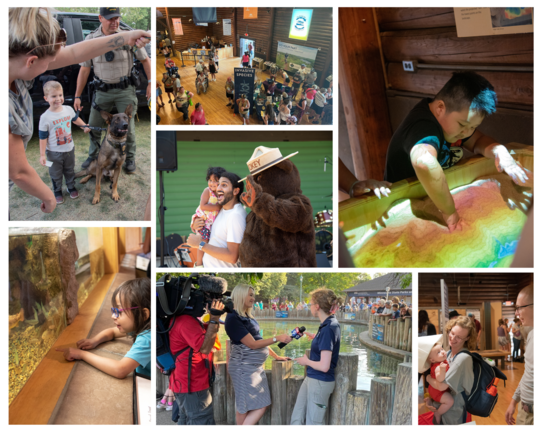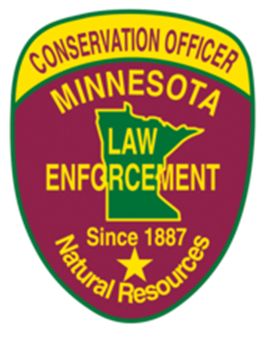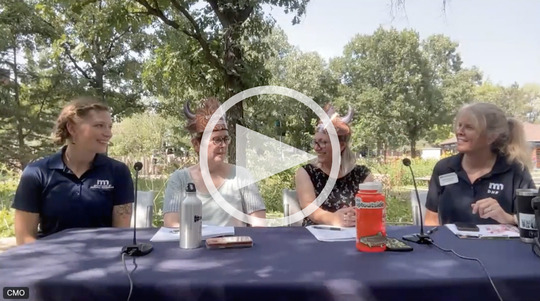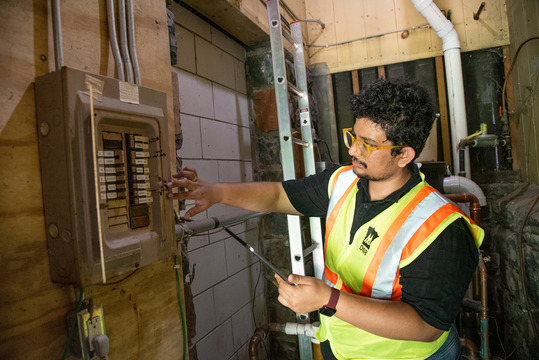DNR is a popular stop at the Minnesota State Fair

The Minnesota Department of Natural Resources building and grounds at the Minnesota State Fair (Aug. 24 to Sept. 4) have been drawing thousands of visitors daily to hear the presentations and bands, have a moment of relaxation by the fish pond and learn about Minnesota's natural resources, conservation and outdoor recreation.
Providing all of these activities and information to fairgoers for the run of the fair requires an immense amount of preparation and work behind the scenes. Minnesota DNR staff and volunteers have dedicated hundreds of hours to create a unique attraction for State Fair visitors and help people learn more about the outdoors.
On Aug. 29, Gov. Tim Walz, Minnesota DNR Commissioner Sarah Strommen, Minnesota Department of Employment and Economic Development Commissioner Matt Varilek, Iron Range Resources and Rehabilitation Commissioner Ida Rukavina and Explore Tourism Executive Director Lauren Bennett McGinty visited the fair to highlight the Minnesota Outdoor Recreation Industry Partnership.
This new partnership promotes and enhances Minnesota's $10 billion outdoor recreation economy, opportunities and industry. Representatives of the partnership toured the Minnesota DNR building and grounds as well as outdoor recreation manufacturers at the fair, such as Paddle North, Polaris, and Clam Outdoors. At the Polaris tent, Walz issued a proclamation declaring Aug. 29 as Outdoor Recreation Industry Day in Minnesota.
 The Minnesota Outdoor Recreation Industry Partnership tour on Aug. 29.
What to know about QR codes

Quick Response, or QR codes, make it easy for mobile users to access information or make a purchase. The Minnesota DNR uses QR codes to facilitate mobile purchases, share information with visitors, and provide access to mobile applications such as LakeFinder and Recreation Compass.
Unfortunately, this convenient technology can be misused by cybercriminals who tamper with or create malicious QR codes to steal money and information.
In October 2021, the Federal Bureau of Investigation Portland Media Office issued a broad warning about QR code scams. Recently, cybercriminals targeted a large energy company using a spoofed Microsoft security notification email attachment to deliver a malicious QR code.
To reduce your risk:
- Verify the QR code is official and created by a trusted source.
- Avoid scanning random QR codes posted in public areas.
- Stop and think before you click on the link.
- Be suspicious if password or login information is requested after scanning a QR code.
- Report suspicious emails that include QR codes or any QR sticker placed on top of another code, especially if you find it at a Minnesota DNR or state of Minnesota location.
- If you use a QR scanner app, keep the app updated and stay alert if it presents advertisements instead of the intended destination.
Public-facing programs required to collect demographic information
By Sept. 1, all public-facing programs serving individual participants must begin collecting required demographic information, if such data is not currently being collected. The Minnesota DNR will provide a status report on implementation to the U.S. Fish and Wildlife Service as part of an audit response in September.
Federal civil rights obligations require programs to track and report race and gender information about DNR program participants. Given the agency's commitment to the values of diversity, equity and inclusion, programs may elect to also collect data on language, age, and disability.
A program demographic data collection guidance document was developed by the Office of DEI and the Office of Policy and Planning. The purpose of this document is to provide guidance on:
- Required demographic information;
- How to collect demographic information; and
- Options for program data collection
A template with examples of demographic questions that can be used in your survey or data collection tool based on the DNR's Customer Contact Data Standards are in the guidance document.
If you have questions about whether these requirements apply to your program, need assistance in creating your plan, or need any other technical assistance, please contact Civil Rights Coordinator Yumi Finney.

Wetland investigations, two-line fishing and more
While the boating season is still in full swing, many people also have turned their attention toward the fall hunting seasons.
The following are several highlights from the weekly Conservation Office reports.
Aug. 21

CO Mitch Lawler (Alexandria) started field training with COC Joseph Scholz. The officers attended the Douglas County Fair, where people had the opportunity to ask questions of Minnesota DNR staff while enjoying great food and good weather.
CO Jacob Willis (Brookston) attended the CO Academy graduation at Camp Ripley as part of the Honor Guard. Willis also investigated a wetlands violation and helped train a conservation officer candidate.
|
Aug. 14
CO Corey Sura (Remer) received a call about someone fishing with too many lines on Wabedo Lake. The caller had tried to tell the suspect that fishing with two lines is not allowed and the suspect responded unkindly and explicitly. Sura found the suspect and issued a citation for fishing with two lines.
WREO Dustie Speldrich (North Metro) worked on Wetland Conservation Act cases and filed deed restrictions. Speldrich found a youth stalled in a class 2 ATV on a road near the family property. He educated the parents and the child on the rules for youth and ATV operation.
DNR updating conservation status assessments for species native to Minnesota
An Ecological and Water Resources project team has started to update the conservation status (S-rank) of all plant and animal species native to Minnesota – that's more than 6,000 species!
The team is actively pulling together data for conservation status assessments and welcomes additional taxa expertise.
What are S-ranks, and how are they developed?
A species conservation status indicates the risk of extirpation from the state for a given species. Species are assigned an S-rank, ranging from S5 (secure) to S1 (critically imperiled) or SX (extirpated). Species status is assessed using a standardized method combining information on rarity, trends and threads – up to eight factors total.
Species conservation status ranks
|
S-rank
|
Status
|
|
SX
|
Presumed extirpated
|
|
SH
|
Possibly extirpated
|
|
S1
|
Critically imperiled
|
|
S2
|
Imperiled
|
|
S3
|
Vulnerable
|
|
S4
|
Apparently secure
|
|
S5
|
Secure
|
|
SU
|
Unrankable
|
|
SNA
|
Not applicable
|
The Conservation Status Assessment Method has been developed and is used by NatureServe Network programs throughout the U.S. and Canada. The assessment method provides structure for consistent ranking, but allows flexibility to use different types of information. This flexibility is important because for many species, especially those that are rare, data are limited. For example, species occurrence data and spatial location is used in all species assessments at a minimum and when information is available on species trends, such as changes in population, abundance, areas occupied or other metrics, those trends are also incorporated in the ranking. The team is using species occurrence data from the Natural Heritage database and other sources as well as spatial data on threats across the state to assign preliminary ranks.
This fall, status factors and preliminary ranks will be reviewed by taxa experts to identify any missing or inaccurate information.
How are they used?
Conservation status rankings are used in conservation planning and prioritization by the Minnesota DNR and external conservation organizations. They are used to inform agency decisions, such as inclusion of species in the upcoming update to the State Wildlife Action Plan as a species in greatest conservation need, or the upcoming revision to the state list of endangered, threatened and special concern species.
Can I get involved?
The team is currently developing preliminary data-driven rankings, which will then go through a taxa expert review process this fall. If you have relevant expertise on a few or many taxa and have not yet heard from the team, please reach out to Julia Geschke to be included as a reviewer.

Wireside Chat: Aug. 23, 2023
 Commissioner Sarah Strommen, Deputy Commissioner Barb Naramore, Education Coordinator Dawn Bahajak, Event Program Coordinator Amelia English, Hatchery Manager Genevieve Furtner, PAT Special Events Coordinator Amy Ellison, and Wildfire Prevention Specialist Karen Harrison joined the Aug. 23 Wireside Chats at the DNR location of the Minnesota State Fair to talk about DNR’s exhibits and attractions this year.
To watch previous Wireside Chats, including both of the Aug. 23 editions, head to the Commissioner's Wireside Chats Intranet page.
Accounts Payable reminders
 Invoices
Utility invoices:
A utility invoice is only metered electric and gas invoices (energy bills), as well as water and sewage invoices but not trash, waste, phone, internet, or propane invoices.
For utility or energy billings that occur monthly, use the account number followed by the statement date (include dashes) as the invoice number. If no statement date is printed on the utility bill, use the service end date as the statement date. For example:
- 02012023_56789 01-31-2023_0000201301 OR
- 02012023_56789 01-31-2023_XCEL ENERGY OR
- 02012023_56789 01-31-2023_0000201301 util
For more information, check out the Submitting Documents to Accounts Payable and File Naming Conventions document.
Employee Business Expenses
New contracts:
New contracts for staff are not yet all in effect. The Expense Allowance by Bargaining Unit has been updated for AFSCME and MAPE bargaining units, effective Aug. 16 and Aug. 19, respectively. For other bargaining units, previous rates will be used until the new contracts are in effect.
Purchasing Cards
The Accounts Payable unit is focusing on paying invoices and business expenses. As a result, the purchasing card log audit and entry will be delayed. All purchasing card logs still need to be submitted on time. Staff will check the logs, but P-card liaisons and P-card holders will see a delay in communication from Accounts Payable staff on any processing issues that need to be resolved such as budget errors, missing documents, etc.
For more information, check out the Accounts Payable page of the Intranet.

Community Forest Project Specialist
Rachel Morice
 Sharing stories and inspiring wonder
By Nikki Henger, Forestry Division outreach specialist
Rachel Morice is the new community forest project specialist for the Forestry Division. She grew up in Rochester and found herself drawn to nature from a young age, especially trees. She studied forestry at the University of Minnesota.
While in college, she discovered the intricate connections between people and nature. This quickly evolved into a passion for sharing stories about plants and inspiring wonder in others.
"I feel really lucky to have a job that revolves around something I'm so passionate about," she said.
After graduating college, she put her skills to the test by working at Rainbow Treecare, completing tree inventory projects and Emerald Ash Borer inspections. Later, at Tree Trust as a program coordinator, she collaborated with schools to enhance their green spaces and teamed up with cities across the metro to craft innovative planting plans for public spaces. Notably, her largest project was orchestrating the planting of 200 trees at Rosland Park in Edina.
Rachel joined the Minnesota DNR team a few weeks ago but is already out in the field working with the public. She said her favorite part so far is collaborating with Minnesota's diverse communities.
“Each community is different and has a unique perspective on how to best engage their residents and improve their community forest, and I am looking forward to learning from all of them," Rachel said.
Rachel said she is most surprised by the sheer number of communities the Minnesota DNR has the opportunity to work with.
“Ranging from small, rural towns to large suburbs, I know I’m going to learn a lot about the geography of Minnesota through this position and I'm looking forward to that," she said.
When she is not working, Rachel runs, paddles, hangs out with her animals, gardens and relaxes at home with some puzzles or video games.
 Work location: Central Office
Job title: Community forest project specialist
Joined the Minnesota DNR: July 2023
Education: B. S. in Forest and Natural Resource Management, University of Minnesota
Something that might surprise your colleagues: I have run six marathons and have six pets (three dogs, one cat, and two snakes)!

Up to code
 Photo credit: Deb Rose
Vijay Ramesh, Buildings and Sustainability Services intern, inspects the electrical panel of the campground clubhouse in Interstate State Park. The Minnesota DNR is required by law to evaluate the overall condition of all 2,900 buildings in our inventory every three years. Vijay is a master’s student in the University of Minnesota’s School of Architecture focusing on sustainable design.
|